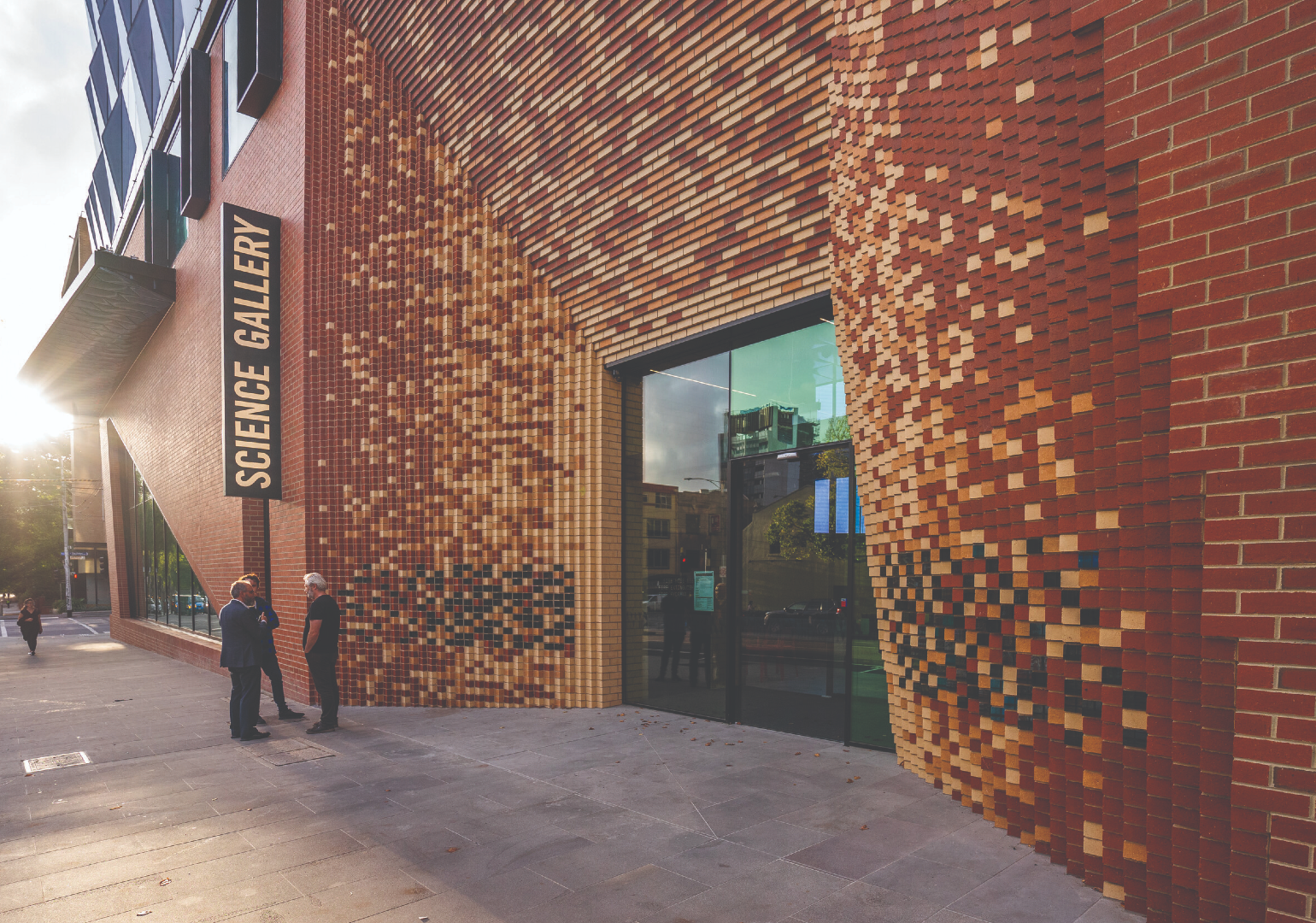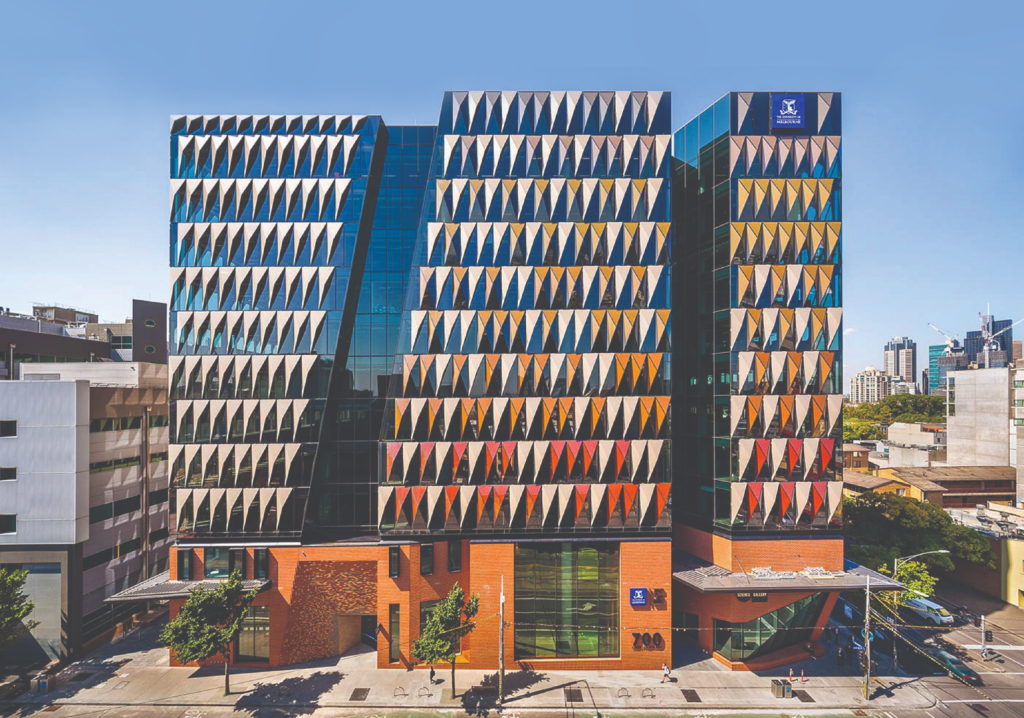Part architecture, part physics and part structural engineering, facade design is a science in its own right.
When the London skyscraper dubbed the “Walkie-Talkie” was being built, light reflecting off the building was so intense it melted car parts.
The sun’s rays were so concentrated on certain areas after hitting the building’s curved facade they were blamed for starting small fires.
It’s a risk Arup Facade Lead for Australasia Simon Barnes was very conscious of when designing Melbourne Connect, a University of Melbourne innovation hub in the suburb of Carlton.
The mixed-use development includes learning spaces, a startup incubator, a science museum, student accommodation and a childcare centre, all spread across half a city block.
Of particular concern was an open-air oculus at the heart of the development, which was filled with plants and surrounded by faceted glass.
“If you have heat reflection and you have panes of glass that are at an angle to one another in a concave shape, you get this array of reflected heat that can focus in a certain spot,” Barnes said.
“You could get the Walkie-Talkie thing happening again.”
The team turned to a unique sunshade design that has become the signature of the entire project.
“It’s as if the surface of each panel on the building were a prism — like a little pyramid turned vertical,” Barnes said.
“[They] have a node at the top of the pyramid, and by moving the node around, you alter the effectiveness of the sunshade.
“If you drag the node across the glass then obviously you close off the glass and you provide more shade. If you pull it back across the other way, you open it up.”
As part of his pitch to win the project, Barnes worked with Melbourne Connect architect Woods Bagot to find the perfect balance between letting daylight in and shading the building from extreme heat.
The team used parametric design — grasshopper scripts — to generate all designs that would hit the desired targets. They then chose a bespoke sunshade geometry that articulates across the entire building.
“It’s quite different to how, perhaps, traditionally we might have designed something like a sunshade, whereby we would use precedence or take our experience to provide a solution and come up with one or two alternatives,” Barnes said.
“This approach has hundreds of alternatives.”

Another innovation was the installation of 226 polished and illuminated glass bricks, which are integrated into the building’s ground floor.
Each glass brick sits in front of a small, high-resolution LED screen that displays historic images of the area.
Barnes, who began his career in architecture, said designing facades combines efficiency, beauty, materials and functionality.
“A good facade is one that functions efficiently and delivers comfort to the occupants of the building, that delivers energy efficiency, that looks beautiful, and one that is not excessive in its use of material,” he said.
Human touch
Aurecon’s Integrated Sustainability Practice Leader David Law leads a multi-disciplinary team that includes facade specialists. He likens building envelopes to human skin.
“Your skin is not just a decoration; it’s not just a shield,” Law said.
Instead, it’s an organ shaping your overall biology and health.
“Your skin regulates your temperature, it absorbs nutrients, it expels toxins, it controls your sense of touch and feel,” he said.
Law said the facade can greatly affect the occupants and operation of a building.
“It controls things like thermal comfort for the people inside, it controls ventilation, energy efficiency … and makes a big contribution towards embodied and operational carbon.”
Law’s team recently completed work on the Paragon in central Melbourne, a 227-apartment building that includes Australia’s first indoor urban forest.
The build incorporates the heritage facade of the former Melbourne Celtic Club.
Law said one of the challenges was the requirement for high-performance glazing in a distinctive champagne-gold colour.
“It does have very good thermal performance,” he said. “It’s a double-glazed, argon-filled curtain wall; it achieves an overall system U-value of 2.7.
“But the challenge there was the colour … getting that reflective gold look, and particularly getting it consistently on all the different facing sides of the building. A lot of work went into researching suppliers and getting the right supply chain.”
The building’s striking exoskeleton was fixed to the outside of the glazing.
“That was done in a really clever way to have minimal connection points through that glass envelope,” Law said. “[It’s] to minimise the amount of thermal bridging … so that it’s not bringing in the cold or the heat.”
Law said a lot of thought went into how to break up the panels to give the impression of a long single element, without having to manufacture and transport something too long.
The team also had to consider how to deal with rainwater getting trapped and ponding in the folds of the exoskeleton.
Law said facade engineers are too often brought into projects late and forced to reverse-justify a decision that has already been made. He wants to see facade specialists consulted during the master plan and concept design stage — before decisions are locked in by planning approvals.
“It’s really important that the facade is not just considered as this window dressing that you clip on at the end,” Law said. “It needs to be approached as a mature integration of the envelope throughout the design process.”
In motion
On the day of his interview with create, Dwayne Van Halewijn, Taylor Thomson Whitting’s Associate Director of Facade, had come from the site of the new Atlassian headquarters in Sydney.
When announced, the project was touted as the tallest hybrid timber structure in the world.
The building aims to use 50 per cent less embodied carbon in its construction compared to a conventional building and 50 per cent less energy than a new conventionally operated building.
It’s seen Van Halewijn and his colleagues work on a bespoke inclined curtain wall facade.
“The facade is almost a zigzag shape as you go up the building and it’s curved in plan,” he said.
“The windows are not nicely vertical, but they’re actually inclined a little bit downwards.”
The glass allows a view of the city from higher levels and creates a tiny roof, or shelf, on each facade panel. The headquarters will operate entirely on renewable energy from day one — much of which will come from solar panels built into the facade.
“These shelves have [photovoltaic] panels all around the building,” Van Halewijn said. “It’s quite innovative.”
Van Halewijn said movement is also a key consideration.
“The building is like an ice lolly,” he said. “The bottom of the building is a thin stick and then there’s a very big ice block on top of it. So with a little bit of wind, it starts moving quite a lot.”
He spent six months on an advanced motion analysis that predicted how the movement of the building could affect the facade.
“We’ve got a concrete and steel structure and a steel exoskeleton,” he said. “Then we have all of these timber floors in between, and then you deal with your aluminium facade.”
Ever-evolving knowledge
Facade specialists pride themselves on the variety of skills within their teams. At Taylor Thomson Whitting, Technical Director of Facade Rami Khalil is a civil engineer who began his career designing industrial hangers and other steel buildings.
He became a facade specialist after working on car showrooms with large panels of glass.
Khalil’s portfolio includes Sub Station No. 164, a sculptural “cloud” that appears to float above two heritage buildings in the heart of Sydney.
The design incorporates a former spirit warehouse and an abandoned electricity station, which gives the project its name.
Khalil said the main design challenge in Sub Station No. 164 came from the extension’s double-curved facade.
“Double-curved facades move in all directions and cause 3D movements, which are difficult to design for,” he said.
Khalil and his colleagues used modelling to anticipate the building’s movements and mitigate the impact on the facade. Like the champagne-gold Paragon building, the glass itself proved difficult, with the engineers sourcing high-performance, curved glass to give the building the right look.
“It was a big challenge to find the perfect glass for the geometry, the thermal and structural performance, the movement and the aesthetics,” Khalil said.
Facade engineering changes, he said, with new materials and fabrication technologies.
“It’s constantly evolving, and close to cutting-edge construction technologies such as the use of [robots] and 3D printing,” he said.
